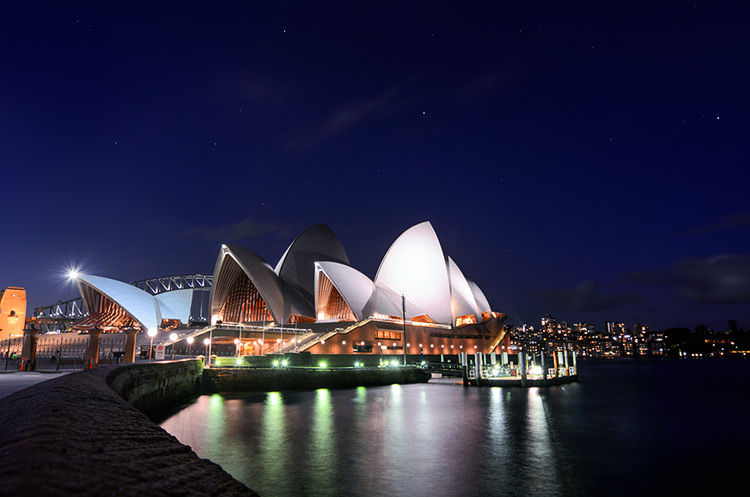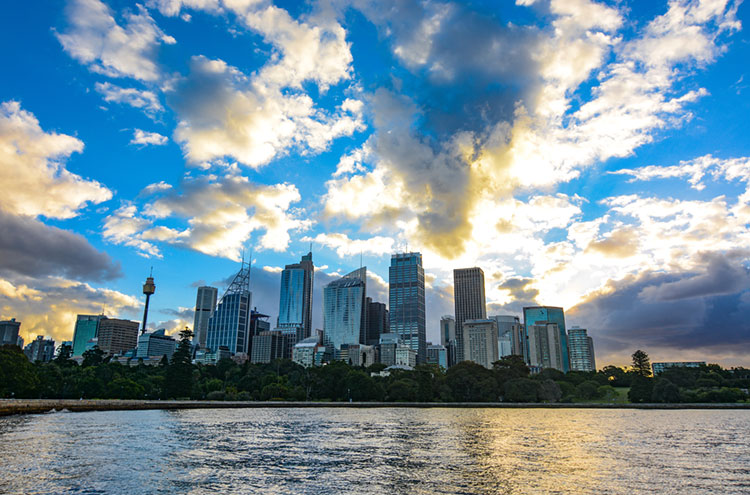FEATURED TRAVEL PHOTOGRAPHY BY DAVID CARILLET
Australia is a land without equal. Both country and continent, it is the sixth largest country by area yet has one of the lowest population densities in the world. Its huge size covers a wide variety of landscapes and wild places, including the largest coral reef on Earth, the Great Barrier Reef. First-time visitors may feel like they have entered a whole new world, as many of the indigenous wildlife and plants are uniquely Australian.

White sails of the Sydney Opera House glowing under a starry southern night sky.

Three Sisters rock formation after sunset in the Blue Mountains of New South Wales.

Central Business District skyline of Sydney framed between the spinnakers of two sailboats.
On June 12th of 1902, Australia became the first country in the world to allow women to stand for election, and the second country in the world to allow women to vote. On the latter, it was preceded only by its neighbor, New Zealand, who extended voting rights to all women in 1893.

Fountain in the lavish gardens of the historical Government House in Sydney.

Dazzling Sydney harbourfront along Circular Quay at night.

Pair of rainbow lorikeets surveying a eucalyptus tree hollow at Royal Botanic Garden, Sydney.
More than 80 percent of Australia's native fauna and flora are found nowhere else in the world. With the exception of the introduced dingo, the extant carnivorous mammals are no larger than a house cat, as the last of the larger apex predators – the thylacine – was hunted to extinction in the 20th century. One in ten native Australian mammal species has gone extinct in the last 200 years, primarily due to the introduction of feral cats and red foxes, as well as other human activities.

Kookaburra cocking its head in search of food from a tree branch lookout.

White sailboats navigating the beautiful Sydney Harbour.

Sunlight-infused evening clouds over the Sydney Harbour Bridge and Opera House.
The inaugural Westfield Sydney to Melbourne Ultramarathon of 1983 was won by a 61-year-old vegetarian potato farmer by the name of Cliff Young. Young was met with amusement when he arrived at the race wearing the gumboots he worked in. He was quickly outpaced and fell to the rear, but while the other competitors slept for up to 6 hours, Young returned to the field early when his coach made a mistake with the alarm. Realizing he could continue running through his exhaustion, Young followed the tactic to the end of the 875 km (544 mi) race, completing it in five days, 15 hours, and four minutes. His shuffle-like running style expended less energy and has since been adopted by some ultra-marathon runners.

Sunset over the HMAS Vampire at the Australian National Maritime Museum.

Nave and stone vaulted aisles of St Mary's Cathedral in Sydney.

View of the Sydney skyline across the harbour from Balls Head Reserve.

Rugged coastline of Lady Bay and submerged rock shelf where several ships met their end.
Australia has the highest rate of gambling in the world, with more than 80 percent of adults engaging in some form of it. In recent years, Australians have lost roughly $24 billion AUD annually to gambling, of which the highest share of losses are spent on the country's more than 200 thousand slot/poker machines, known locally as pokies.

Sunset over the Sydney CBD skyline, as seen from the Royal Botanic Garden.

Ghostly white trunks of eucalyptus trees along a walkway at Sir Phillip Game Reserve in NSW.

Burst of blue and white fireworks over the Sydney Opera House and Harbour.
The iconic Sydney Opera House cost $102 million AUD to build, against an original estimate of $7 million. It was completed in 1973 and designated as a UNESCO World Heritage site in 2007. The unique and complex design of the Opera House presented great challenges for construction of the shells that form its huge sails. An eventual solution was found by deriving the shells from a single sphere, which allowed prefabrication from a repetitive geometry to ensure uniform curvature and reduced construction costs.

Architectural symmetry of Sydney's world-famous icon, the Opera House.

View of the Sydney Harbour Bridge from the hill at the observatory during evening.

Hornby Lighthouse, erected in 1858 at South Head, the southern entrance to Sydney Harbour.
The air quality in Tasmania has been assessed as possibly the cleanest in the world, with purity levels similar to Antarctica. This is due to prevailing westerly winds from the Southern Ocean which have had no recent contact with land and thus act as a baseline for measuring air quality. The Cape Grim Baseline Air Pollution Station has been measuring and archiving air since 1976 and has been instrumental in documenting the rise of CO2 in the atmosphere. Its data has been used in international assessments of climate change and ozone depletion.

Sunset over Mount Solitary in the Jamison Valley of New South Wales, Australia.

Centenarian trunk of a Moreton Bay fig, or Australian banyan, at The Domain in Sydney.

Cruise ship docked at Circular Quay in Sydney, as seen from the Harbour Bridge.